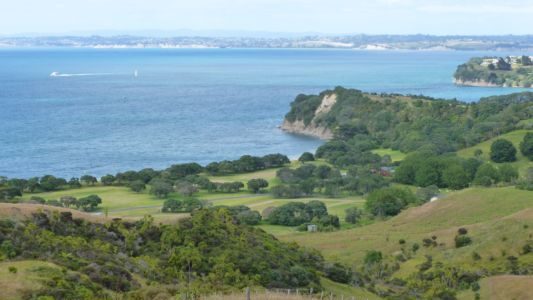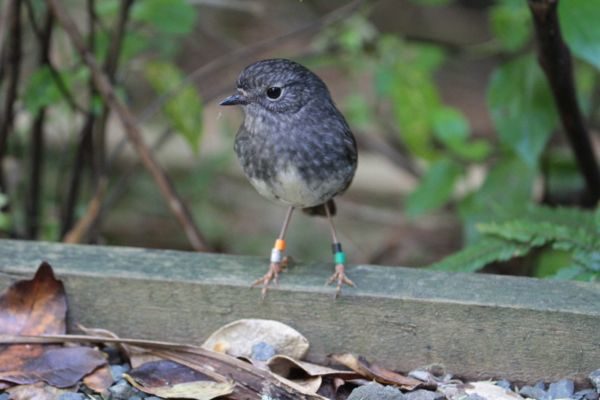Observant visitors to Shakespear Regional Park recently, may have observed a sheep wearing a transmitter. They might even have spotted volunteers, dressed in high-vis vests, in pursuit of that sheep, tracking it with direction-finders. Anyone witnessing this intriguing spectacle no doubt wondered why…

Shakespear Park is located on the Whangaparaoa Peninsula, 50 minutes north of Auckland Harbour Bridge and is an open sanctuary for wildlife, with roughly a third of the sanctuary land still used for farming (hence the sheep) and another third used by the NZ Defence Force (hence the high-vis vests worn by Shakespear Open Sanctuary Society Inc (SOSSI) volunteers whenever they are working in the park. Volunteers are, of course, highly unlikely to be shot at, but it doesn’t hurt to take precautions.
SOSSI volunteers are currently in training, honing their skills with direction-finders in readiness for the day when they will be tracking little spotted kiwi. In just a few weeks time, 20 of our smallest kiwi species are due to be released at Shakespear, with half the birds coming from Kapiti Island and the other half coming from Tiritiri Matangi, helping to keep the breeding population as diverse as possible. A further 20 birds will be released in about a year’s time.

The little spotted kiwi will be fitted with transmitters and will be closely monitored when first released. In the meantime, the obliging sheep helps make tracker training more realistic by providing a moving target.
The release of little spotted kiwi will be the culmination of years of preparation and fund-raising for SOSSI. The sanctuary is fenced across the narrow end of the Whangaparaoa Peninsula, enclosing an area of 500 ha and has been pest-free – apart from mice – for five years. The predator-proof fence can potentially be breached, however, at the coastal ends where it meets the sea.
“There are occasional incursions,” says SOSSI Chairman, Peter Jackson, “But our processes for dealing with incursions have worked.”
Additional modifications at the fence ends and within the park have been made in preparation for the kiwi release.
“We’ve put in low fences near the end of the pest-proof fence,” says Peter. “They go down to the nearest cliff so that kiwi can’t get on to the beach. There’s also a regional sewage treatment plant within the Defence Force land, with big aeration ponds. The sloping sides of the aeration ponds are covered in slippery polythene so have been fenced off to stop kiwi sliding in. And there are World War II gun emplacements – basically concrete holes in the ground – they’ve been fenced off for the kiwi as well.”
The construction work has been going on since the beginning of the year. Funds have also needed to be raised for these and other translocation costs.
“It’s costing $35,000 for the first 20 little spotted kiwi,” Peter says.
Little spotted kiwi aren’t the first translocation to Shakespear Open Sanctuary.
“Last year 40 North Island robins were released,” says Peter. “Thirteen pairs nested in spring and 34 chicks were raised.”
Volunteers captured and banded all the chicks.
“We’ve asked locals to look out for robins,” Peter says. “They’re very territorial and some are sure to leave the sanctuary. But there’s 10km of concentrated housing once they leave, so hopefully they’ll stay.”
Giant weta, saddlebacks and skinks are also being considered for future translocations. Ongoing fundraising will be needed to support this, however.

“We’ll need to raise $20,000-$30,000 per year for the next few years,” says Peter.
Shakespear has already proven to be a good habitat for native birds and lizards to thrive.
“We’ve got 7 of the 9 lizard species that live in the Auckland mainland region here already,” says Peter. “And tui are our commonest bird – they’re more common here than sparrows.”
Bellbirds, however, are proving more elusive at Shakespear.
“There are just a handful,” admits Peter. “Bellbirds aren’t establishing naturally, even though Tiritiri Matangi is only 3km away. It’s frustrating. At Tawharanui Open Sanctuary, bellbirds arrived en masse from Little Barrier Island, although no-one knows why.”
Hopefully some of Tiritiri Matangi’s bellbirds will organise their own excursion to investigate Shakespear some time soon. In the meantime, SOSSI volunteers are carrying out monitoring surveys to check on the native species they already have.
Many of the seven skink and gecko species naturally present at Shakespear were discovered by SOSSI’s volunteers. Other lizard species were discovered entirely by accident.
“Our second forest gecko was found by a cleaning woman at the defence base,” Peter says. “It was running around the room!”
As well as skink surveys, SOSSI volunteers help protect New Zealand dotterel nesting on the beach and take part in regular Tuesday morning working bees organised by Auckland Council rangers.
“We’ve got about 100 active volunteers,” Peter confirms. “The rangers send out a weekly notice of what volunteer work needs doing. Every Tuesdays, the rangers list work on a big noticeboard and people can pick a job they’d like to help with. There are usually about half a dozen things to do.”
Tuesday tasks can include helping on the Shakespear farm – repairing fences, making gates, weeding.
“Now that we’ve got rid of possums and rabbits, the weeds grow just as fast as the natives ,” says Peter.
Other work may involve helping out in the plant nursery where 12,000 seedlings per year are raised – about half the plants needed annually for habitat restoration at Shakespear.
Volunteers also regularly check the traplines, but this is a task they can do at a time that best suits the individual, so while retired people make up the bulk of the Tuesday volunteers, people of all ages help out with the traplines. Even with the pest-proof fence, predator control is a key part of SOSSI volunteer work.

“We’ve got around 500 traps and bait stations,” says Peter, “with an intensive area outside the fence in the regional park.”
All conservation planning is done by Auckland Council staff and senior ranger Matt Maitland, who is also responsible for Tawharanui Open Sanctuary, works closely with SOSSI trustees and volunteers.
“Shakespear Open Sanctuary is a good example of mixed use,” says Peter. With the regional water treatment plant and the Defence Force land there are big trucks going in and out all the time. That increases the incursion risk, but all the contractors and landowners are very helpful. And the park gets ½ a million visitors every year,” he adds.
That’s a lot of visitors! Clearly Shakespear Open Sanctuary is already a spot well-loved by kiwis looking for a special day out and in just a few months time, they’ll be joined by more kiwi of the feathered sort. But in the meantime there’s a sheep on the hillside doing her best to act like an elusive bird and a small band of watchers keeping track of her. That’s dedication!
TIP TO SHARE
Keeping track of member subs is one of those admin jobs that can take up a surprising amount of a volunteer committee member’s time. SOSSI solved the problem by changing from an annual subscription to a 5-yearly one. There’s much less admin involved – and you get to keep your members for a minimum of five years, not one.
Photographs: Don Snook, Dave Craddock, Peter Jackson, Bruce Harrison.
SOSSI website
SOSSI Facebook Page

